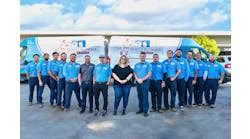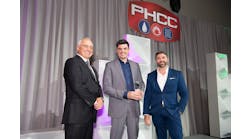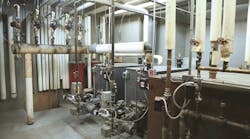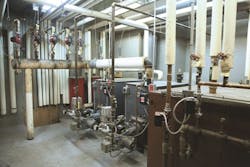MORRISVILLE, VT. — Kevin Amyot had serious qualms last spring when contractor Ed Friedrich first proposed a major pump-retrofit project at the Sunset Motor Inn, one of the properties Amyot manages for the H. A. Manosh Corp. in Morrisville. Friedrich’s $13,000 estimate called for the replacement of 18 fixed-speed circulating pumps in the heating system at the Sunset with 10 circulators from the Grundfos Pumps Corp.
Six of the pumps would be conventional, fixed-speed circulators. The remaining four replacement units would be energy-saving, variable-speed, “smart” circulators. This quartet coupled ECM (electronically commutated motor) technology with sophisticated electronics for matching pump output to changing system demand — automatically and without human intervention — delivering substantial energy savings in the process.
Amyot was impressed with the new technology. Friedrich had already done a successful retrofit at the home of company president Howard Manosh, and the latter’s downsized electric bills provided testimony of the energy-savings the new smart circulators could provide.
Still, $13,000 was a hefty outlay to update a system that continued to function at an acceptable level most days of the week.
“At the outset, I just couldn’t see how we’d recoup our investment any time soon,” said Amyot.
Not that the older circulators didn’t have performance issues of their own. Installed in the 1980s, the pumps generated a fair amount of mechanical noise while moving hot water from the 500,000 Btuh coal-fired stoker and two backup, propane-fired boilers in the motel’s mechanical room through hundreds of feet of pipe to Sunset’s 59-unit guest quarters. All the humming and vibrating was a frequent target for guest complaints. Further aggravating the situation, the system operated round-the-clock whether hot water was needed or not.
Then there were the maintenance headaches: Given the pumps’ age, repairs were many and often. Couplers inside the pumps would weaken and break, or their bearing assemblies would need rebuilding. And because a motel must never be without hot water, all such breakdowns were tantamount to emergencies. Amyot estimates he spent between $1,000 and $1,500 each year on parts alone. For the sake of speed, internal personnel handled most repairs; but if he expensed their labor as well, the total annual maintenance tab would have approached $3,000.
One of the best
In the end, the high regard Howard Manosh and Kevin Amyot have for the professional skills of Ed Friedrich trumped their worries over cost and payback. A 22-year veteran of the plumbing and heating industry, Friedrich established County Plumbing & Heating with two other partners, Gina Lanpher and Tom Sheltra in 2003.
“Ed is highly experienced,” said Amyot. “But he also stays abreast of the latest trends and keeps us informed of them.”
So Amyot green-lighted the retrofit project last summer. Following the three-day installation, validation of this decision came almost immediately in the form of a lower electrical bill. In fact, after three months of operation, Amyot was projecting a swift payback of one year, and translated into dollars, the hotel’s November electric bill was $840 versus $2,400 three months earlier.
“With the savings on electricity alone, I can see a payback of between 18 to 24 months,” said Amyot. But he also figures to need 20% less coal, since the stoker now fires strictly on demand, as opposed to 24/7. Meanwhile, maintenance has dropped to zero.
“Factoring in the savings on coal and no maintenance costs,” said Amyot, “I anticipate getting our $13,000 back some time next summer. I am amazed at all the energy we are saving: We are very happy that Ed persuaded us to do the retrofit.”
Good neighbors
Personal relationships played a big role in this project.
“I’ve known Howard all my life,” said Friedrich.
“Ed is like another son to me,” said the 77-year-old Manosh.
But even beyond their friendship, Manosh and Friedrich are next-door neighbors, which is how Friedrich introduced the concept of smart, variable-speed pumping to his friend. Last winter, Friedrich approached Manosh about a new wet rotor circulator that Urell’s Desroches had shown him: the Alpha. When equipped with ECM technology, a variable speed circulator like the Alpha can deliver the identical flow rate as an induction-type pump, yet consume only half the energy.
Knowing that Manosh was less than thrilled with efficiency of his home’s hydronic baseboard and radiant floor heating system, Friedrich suggested this new circulator could lower his friend’s monthly electric bill. Manosh was game.
Manosh was impressed enough with the results — he is saving about $50 per month on his electricity — to contemplate similar retrofits for his many business holdings, including the Sunset Motor Lodge, where he saw the biggest potential for Friedrich’s energy-saving pumps.
“Howard knew that the motel had several pumps that operated round-the-clock, just like at home,” said Amyot, “so he asked that I develop a plan and a budget.” Once Amyot felt reassured about his cost concerns, Friedrich went to work overhauling all the pumps used in Sunset’s heating system.
Intelligent design at work
Friedrich installed four variable speed circulators to move hot water from the main header to the four main heating zones and the various subzones throughout the L-shaped motel structure. One of these circulators is an Alpha (maximum flow rate of 25 GPM), serving five guest rooms in one small section of the hotel. The remaining three are the more powerful Magna 32-100 circulators (maximum flow rate: 180 GPM), each handling 12 guest rooms. Also made by Grundfos, the Magna features the same intelligent design as the Alpha, adjusting flow rates to changing system demand automatically.
“I set all four circulators on AutoAdapt,” said Friedrich, “because I knew that the load-matching feature along with the design of the motor itself would deliver the major reductions in electrical consumption.”
Friedrich’s system overhaul did not include replacing larger equipment: the stoker, two back-up propane-fired boilers and zone valves for the four main heating zones stayed in place. The function of a zone valve in a hot-water system is to permit hot water from the primary piping loop to enter its zone to provide heat through baseboard or a radiator. Once a thermostat, either integral to the valve or a separate device, indicates the zone has reached a preset temperature, it signals the valve to close, thus halting the hot-water flow into the zone.
But at Sunset, the thermostats and zone valves were not connected with the old circulators, which were allowed to run nonstop, even when no hot water was needed. As part of the redesign, Friedrich had an electrician run a wire from the end switch for each zone valve to the appropriate Magna or Alpha circulator. When a zone no longer needs hot water, the valve closes and — through a pump relay switch — signals the circulator to shut off as well.
The continuous circulation of hot water in the old system wasted energy in one other important way: heat loss through all the piping that runs through the structure. Load-matching smart circulators operating less frequently have also reduced that wasted energy.
Additional circulators
The project also included the installation of six additional, induction motor-type circulators made by Grundfos. A cast-iron, three-speed, UPS43-44FC circulator, the SuperBrute, moves hot water from the stoker to the main header through the two backup boilers in a reverse-return manner. The 500,000 Btu/h stoker generates sufficient hot water for both space heating and domestic hot water the majority of the time, especially in the summer, according to Friedrich.
“But if the stoker cannot handle the load, one or both of the propane-fired boilers will activate to boost the water temperature to the set point,” said Friedrich.
The main header feeds both the four space heating zones, controlled by the three Magna circulators and the Alpha; as well as the two domestic hot water lines for the motel’s recirculation system. For each of the two lines, another cast iron, three-speed Super Brute (UPS26-99) moves hot water from the main header to an Everhot Heat Exchanger Water Converter, which transfers heat to the potable water that ultimately circulates to the guest rooms.
Once the water moves through the converter, a bronze UPS26-99BFC circulator pumps it to a 400-gal. storage tank. Hot water is then circulated by a stainless steel UPS15-35SFC circulator from the two storage tanks to any of six recirculation lines looping the entire motel. This single pump now does the work of six different pumps that were removed by Friedrich during the retrofit.
The six recirc lines are essential because of the long water-supply lines that are inevitable in a hospitality structure like the Sunset, noted Friedrich.
“The runs are laid out so that the distance between a recirc loop and any hot-water outlet is relatively short — 8 or 10 feet, typically — minimizing the wait. Without this type of setup, guests would be standing around an uncomfortable amount of time, waiting for showers, and a lot of potable water would be wasted down the drain,” said Friedrich.
Amyot also bought two additional smart circulators — an Alpha and a Magna. But these were immediately put on the shelf to serve as spares “just in case,” Friedrich said. “No matter what the quality of the product, this motel cannot afford to be without hot water. The extras were purely for security.”
Get smart
One successful project generates another at Manosh. Since the Sunset installation, the company has upgraded its 20,000-sq.ft. headquarters with a new boiler and all new smart pumps, as well as a 15,000-sq.ft restaurant on the Sunset property that received new pumps as well.
“We burn No. 2 fuel oil there, and the price is rising all the time,” said Amyot. “We needed to do something at that facility.”
The Manosh experience is part of a larger trend in the hydronics field. Until recently, conventional wisdom insisted that variable-speed technology be confined to pumps of 50 horsepower or more that ran nonstop or very close to it. Fuel and equipment costs simply didn’t justify applying this sophisticated technology to smaller pumps, especially the fractional-horsepower variety. With energy costs being so low, the economic penalty for oversizing the pumps was easy to ignore or dismiss.
But attitudes have changed with energy prices and environmental awareness over the past decade, especially since the downturn that began in 2008. Today, facility owners and managers are relentlessly searching for ways to cut the cost of ownership in every facet of operations, large and small and in between, including pumps. With the latter, the energy needed to operate one represents 85% of its life-cycle costs, hastening the drive for higher efficiency.
“To recoup our $13,000 investment in only one year is better than I could have anticipated,” said Amyot.
“Best of all, my maintenance headaches are at zero,” he continued. “I can go home every evening and not worry about having to dispatch a tech to a property to fix a broken pump overnight, to make sure we have enough hot water in the morning. It’s tough to measure in dollars, but that kind of peace of mind is huge for me, too.”



